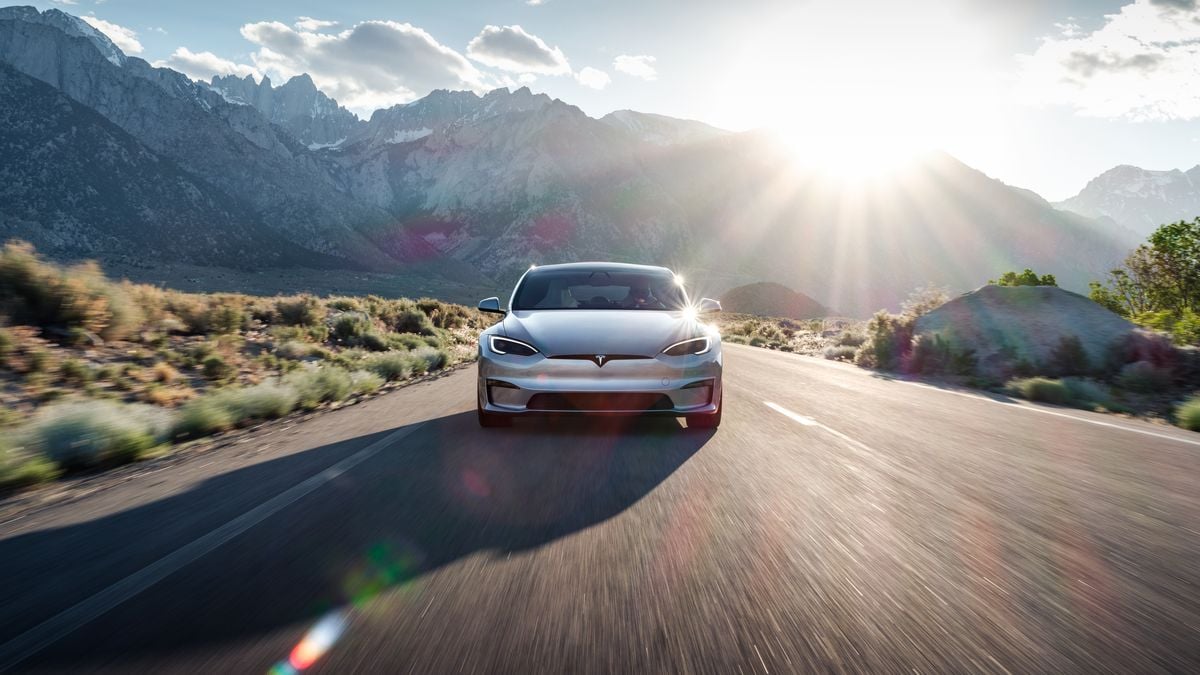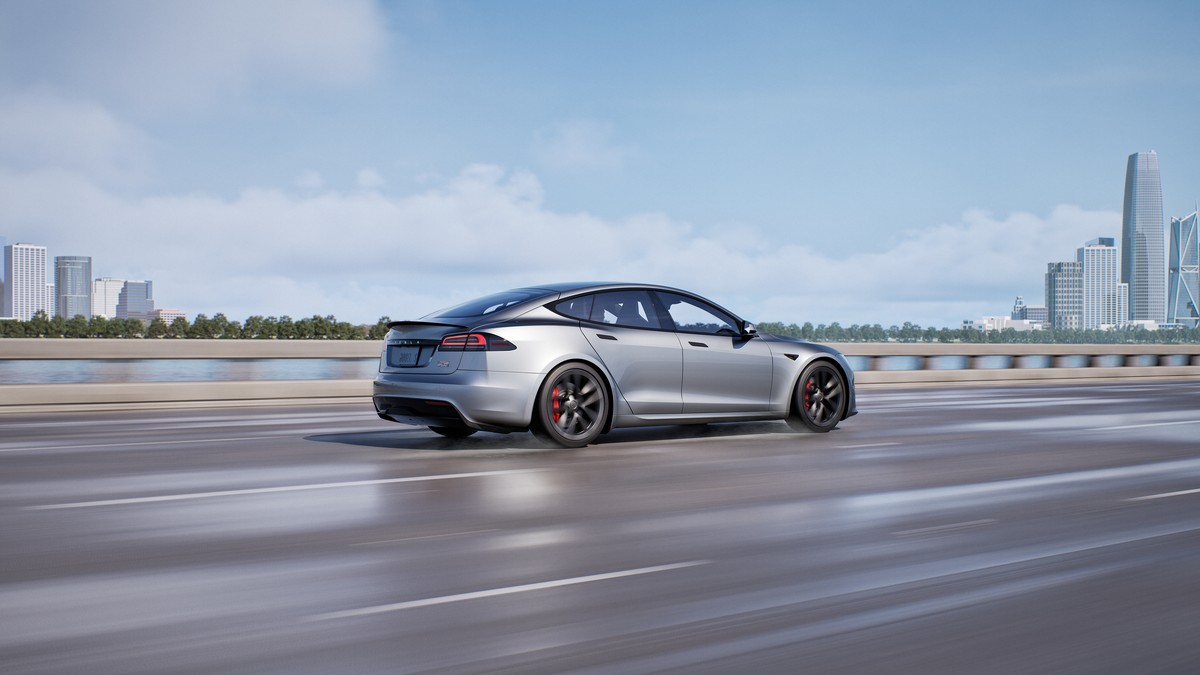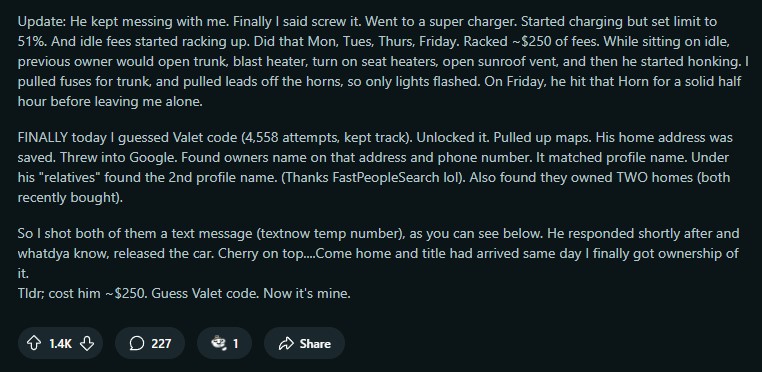Few transitions should be as seamless as switching to an electric vehicle. The promise of quiet performance, reduced emissions, and freedom from Big Oil's grip has lured many drivers into the electric revolution.
When a Used Tesla Model S Is Remotely Controlled
But as one new Tesla owner recently discovered, the future comes with some decidedly unfuture-like problems, particularly when the previous owner refuses to let go of their digital tether. What unfolded next was part Seinfeld, part Orwell, and all very 2025.
Here’s how our unlucky friend, Reddit user Vladdroid, explained it in his now-legendary post on r/TeslaLounge:
“New to Tesla. Bought a Tesla Model S. It has free supercharging.. 2 days later, seems like the previous owner locked it into Valet mode. And it keeps blasting AC (60°f outside currently) when I park it. Apparently they never unbound the car, and I didn't know that was a thing (new to Tesla 🤷♂️🤦♂️). And now they've been dicking around with me for the past 5 days. Turn AC on full blast while running seat heaters, unlocking, keeping it in Valet mode and dropping speed limit to 50mph, locking my frunk/glovebox.
Currently waiting to get paperwork (have only proof of purchase/receipt) in order to transfer via Tesla support. Called twice, both times was said to get registration and send to them before they can transfer.
In meantime, would I theoretically be able to charge the battery at a Supercharger, and leave it to collect idle fee to charge his account in hopes that he stops dicking around and releases the vehicle? Assuming the fees won't get slapped on my account after transfer? I need it to get to work, but they keep draining my battery ~60% a day during parking, and worried they might try visit it haha.
Update: He kept messing with me. Finally I said screw it. Went to a super charger. Started charging but set limit to 51%. And idle fees started racking up. Did that Mon, Tues, Thurs, Friday. Racked ~$250 of fees. While sitting on idle, previous owner would open trunk, blast heater, turn on seat heaters, open sunroof vent, and then he started honking. I pulled fuses for trunk, and pulled leads off the horns, so only lights flashed. On Friday, he hit that Horn for a solid half hour before leaving me alone.
FINALLY today I guessed Valet code (4,558 attempts, kept track). Unlocked it. Pulled up maps. His home address was saved. Threw into Google. Found owners name on that address and phone number. It matched profile name. Under his "relatives" found the 2nd profile name. (Thanks FastPeopleSearch lol). Also found they owned TWO homes (both recently bought).
So I shot both of them a text message (textnow temp number), as you can see below. He responded shortly after and whatdya know, released the car. Cherry on top....Come home and title had arrived same day I finally got ownership of it.
Tldr; cost him ~$250. Guess Valet code. Now it's mine.”
This was a full-blown carjacking. Through Tesla’s mobile app, the previous owner wielded remote control, blasting the A/C while running seat heaters, unlocking and relocking the doors, keeping it in valet mode, and, just to make sure nobody could enjoy a quiet night, honking the horn for a solid 30 minutes.

The battery was being drained by 60% daily while parked, making an already frustrating scenario into a logistical nightmare. Imagine buying a house, only to find the last owner still has access to your thermostat, door locks, and Alexa. Funny on TV. Less so in real life.
Tesla Model S Depreciation: What Every Buyer Needs to Know
- The Tesla Model S experiences significant value loss shortly after purchase. Within the first three years, it can depreciate by approximately 30–40%, influenced by factors like frequent updates to newer models and price reductions on new vehicles.
- Over a five-year span, the Model S may depreciate by up to 71%, with resale values dropping from an original price of around $88,880 to approximately $26,024. However, after this period, the depreciation rate tends to stabilize, making older models potentially more cost-effective for buyers.
- Tesla's strategy of reducing prices on new models, coupled with rapid advancements in EV technology, can make older Model S vehicles seem outdated, further accelerating depreciation. This dynamic has led to significant value drops, with some owners reporting losses nearing $100,000 within two years.
- Recent data indicates that the Model S has one of the steepest year-over-year depreciation rates among used vehicles, with a 17.2% drop equating to nearly $10,000 in value loss over a single year.
Commenters in the Tesla community forums were baffled and alarmed. “That’s concerning because in theory they could just take the car back with the remote start option,” one user wrote. “Personally, I would be concerned to drive it anywhere with someone having app access,” added another. No kidding. The new owner even began parking in a garage, just in case the car decided to take itself for a joyride.

Faced with Tesla’s slow response, requiring full registration documents before ownership could be transferred digitally, Vladdroid went on the offensive. In what can only be described as guerrilla EV warfare, he began charging the vehicle at a Supercharger, then deliberately let idle fees accrue under the previous owner's account. “Did that Mon, Tues, Thurs, Friday. Racked ~$250 of fees,” he wrote. Meanwhile, the previous owner retaliated with a symphony of disruptions, opening the trunk, activating the sunroof, and that now-famous horn blast. In a fit of 21st-century problem-solving, our hero pulled the horn fuses and disconnected the trunk relay.
Then came the digital sleuthing. After 4,558 attempts to guess the valet code, the lock finally broke. And that’s when he struck gold, the car's navigation history revealed the previous owner’s home address.
How a Redditor Found His Tesla Hacker
A few Google searches later, he had names, numbers, and even secondary residences, thanks to services like FastPeopleSearch. “So I shot both of them a text message,” he said. The message? Basically: “Stop the harassment, or keep racking up Supercharger fees.” Suddenly, silence. Then release. Then, as if scripted, the car’s title arrived in the mail that same day.
Connected-Car Vulnerabilities: Tesla Ownership Transfer Nightmare
What reads like a rejected Black Mirror episode is actually a hard lesson in how vulnerable the connected car ecosystem can be. Tesla vehicles are technological marvels, crisp, quiet, brilliantly engineered, but the reliance on cloud infrastructure and app control creates a glaring risk for secondhand buyers.
Tesla’s system, for all its innovation, clearly isn’t bulletproof. In this case, the automaker told the buyer they could expedite the transfer with proper documentation, but until that paperwork went through, the car was effectively a shared custody nightmare. It’s a bizarre situation to be in. And while it's amusing in hindsight, for the guy living through it, it was ten days of escalating stress, wasted charge, and horn-induced migraines.
Step-by-Step Guide: Resetting and Transferring Your Tesla Model S
- Ensure the transaction is complete, including payment and title transfer. Before handing over the vehicle, perform a factory reset via the car's touchscreen (navigate to Service > Factory Reset) to remove all personal information and unlink your Tesla account.
- Open the Tesla app, tap the profile icon, select "My Products," choose your Model S, and tap "Remove or Transfer Ownership." Enter the new owner's name and email address associated with their Tesla account. Tesla will send a confirmation email to complete the transfer.
- The new owner should accept the transfer link sent by Tesla. If the seller hasn't initiated the transfer, the buyer can add the vehicle in their Tesla app by selecting "Add Product" and submitting required documents, such as a driver's license and proof of ownership.
- Tesla typically processes ownership transfers within 3–5 business days. During this period, the buyer should ensure they have the key card or fob to access the vehicle. Once the transfer is complete, the vehicle will appear in the new owner's Tesla account, granting full access to app features and services.
Let this be a warning to all future EV buyers: ownership doesn’t end at the title. If you’re buying a used connected car, whether it’s a Tesla or anything else with remote access, demand a full digital reset from the previous owner. Confirm it, double-confirm it, and make sure Tesla or the manufacturer acknowledges you as the new master of the machine. Otherwise, you could find yourself at war with a person who never quite left the driver’s seat. And the worst part? He’s got your horn button.
If this situation happened to you, what would be your next course of action?
Let us know in the comments below.
Image Sources: Tesla Newsroom
Noah Washington is an automotive journalist based in Atlanta, Georgia. He enjoys covering the latest news in the automotive industry and conducting reviews on the latest cars. He has been in the automotive industry since 15 years old and has been featured in prominent automotive news sites. You can reach him on X and LinkedIn for tips and to follow his automotive coverage.







Comments
But isn't that just part of…
Permalink
But isn't that just part of the fun and excitement of owning a Tesla? And who buys a used Tesla, right?
This is so funny. He…
Permalink
In reply to But isn't that just part of… by Buzz Wired (not verified)
This is so funny. He probably voted for Bidey and Kammy too. Caviaty Emptoy.
Lol people with names like…
Permalink
In reply to This is so funny. He… by Solo (not verified)
Lol people with names like yours are getting deported now, have you been deported yet? Doesn't matter if you're in the country legally when you have a name like yours.
Dems were big buyers of…
Permalink
In reply to This is so funny. He… by Solo (not verified)
Dems were big buyers of Tesla when they first came out. Now they are selling them and trying to get back at people who are now buying Tesla products. The former owner is screwing with the new generation of Tesla customers.
Yup. And they're still…
Permalink
In reply to Dems were big buyers of… by Harry Sak (not verified)
Yup. And they're still buying EVs, just from other manufacturers. It's also amusing to me the amount of Never-EV /Always Diesel people who bought Teslas before Trump silently tossed Musk under the bus.
Appreciate the insight! The…
Permalink
In reply to Yup. And they're still… by Whynot (not verified)
Appreciate the insight! The EV world definitely brings together a wide mix of folks. No matter the brand or background, I just hope everyone gets a smooth and safe ownership experience!
Thanks for reading! I don’t…
Permalink
In reply to Dems were big buyers of… by Harry Sak (not verified)
Thanks for reading! I don’t think it’s political more likely just a case of someone not properly disconnecting their account.
Thanks for reading! I can’t…
Permalink
In reply to Dems were big buyers of… by Harry Sak (not verified)
Thanks for reading! I can’t speak to political motives, but I shared this to highlight how important it is for Tesla to improve ownership transfer processes. Hopefully, this helps others avoid the same issue!
I bought used Teslas over…
Permalink
In reply to But isn't that just part of… by Buzz Wired (not verified)
I bought used Teslas over the years - but I'm also smart enough to know that the previous owner must "release" the vehicle to the new owner via the app.
Can't imagine not knowing that and having someone mess with me for weeks. I'd be livid too.
Great cars btw, American made.
Totally agree, great cars…
Permalink
In reply to I bought used Teslas over… by Not Elon Musk (not verified)
Totally agree, great cars and a great point! This was a big learning moment for me, and hopefully it helps others avoid the same situation.
Actually 50% of Tesla's…
Permalink
In reply to I bought used Teslas over… by Not Elon Musk (not verified)
Actually 50% of Tesla's parts are imported from China, Mexico,and Canada -making the term "Assembled in America" more accurate.
That's certainly one way to…
Permalink
In reply to But isn't that just part of… by Buzz Wired (not verified)
That's certainly one way to look at it, a very adventurous one!
Tesla has less depreciation…
Permalink
Tesla has less depreciation than any other EV. The tax credit reduces market value from the original price causing lower resale value (depreciation). The tax credit suppresses the value of used EVs and non-EVs by enticing some potential car buyers to purchase and new EV with the tax credit.
Great insight! The tax…
Permalink
In reply to Tesla has less depreciation… by Deng Li (not verified)
Great insight! The tax credit definitely plays a role in shaping the used EV market.
Great insight! The tax…
Permalink
In reply to Tesla has less depreciation… by Deng Li (not verified)
Great insight! The tax credit definitely plays a role in shaping the used EV market.
Tesler is heading the way of…
Permalink
Tesler is heading the way of My pillow
You mean people hating them…
Permalink
In reply to Tesler is heading the way of… by Ken D. (not verified)
You mean people hating them for their beliefs?
You can't say that, the…
Permalink
In reply to Tesler is heading the way of… by Ken D. (not verified)
You can't say that, the pillow guy used to have a severe drug problem...oh.
What's My Pillow?
Permalink
In reply to Tesler is heading the way of… by Ken D. (not verified)
What's My Pillow?
I'm no tesla fan but imagine…
Permalink
I'm no tesla fan but imagine them letting you swap without providing registration, anyone could do it.
I have purchased four used…
Permalink
I have purchased four used Teslas in the past couple of years. The most recent was a Model X with unlimited free Supercharging from a private party. We met at a bank where we both have accounts. He had the title. I transferred the money from my account to his. He transferred the car from his Tesla account to mine. It was in my Tesla account within a couple of minutes. Two of the other purchases were from private parties, one from a dealer. Transfer was just as easy. If the Model S was purchased from a dealer, it was the dealer's fault.
Sounds like you’ve had some…
Permalink
In reply to I have purchased four used… by Richard Samuels (not verified)
Sounds like you’ve had some smooth experiences awesome to hear! the transfer can be quick and easy when done right. This situation was definitely a wake-up call for better handoffs. Thanks for sharing man!
I feel like a visit to the…
Permalink
I feel like a visit to the police would be appropriate in a case like this.
I think you deserve some…
Permalink
I think you deserve some compensation here, what a cheesy high school thing to do.
Lawsuit. What the previous…
Permalink
Lawsuit. What the previous owner did was illegal.
This wasn't a used Tesla, it…
Permalink
This wasn't a used Tesla, it was a repossessed one with a vindictive previous owner it seems.
this one had a unique twist…
Permalink
In reply to This wasn't a used Tesla, it… by Derb (not verified)
this one had a unique twist with the repossession and a previous owner who hadn’t let go.
Kool story bro
Permalink
Kool story bro
I'd be visiting the previous…
Permalink
I'd be visiting the previous owner with a baseball bat.
I want to know how he bought…
Permalink
I want to know how he bought it.